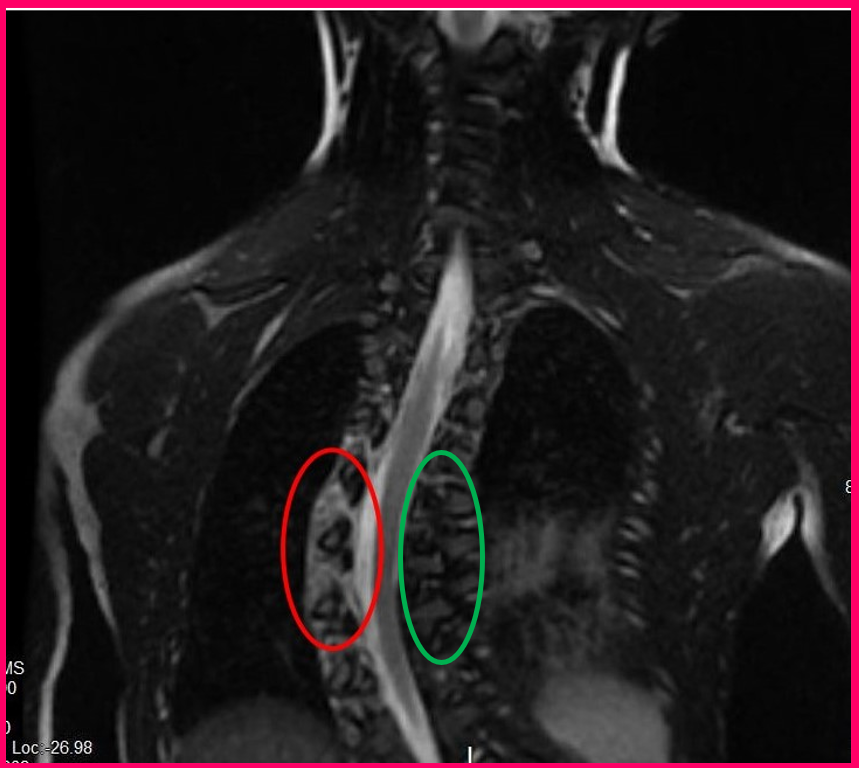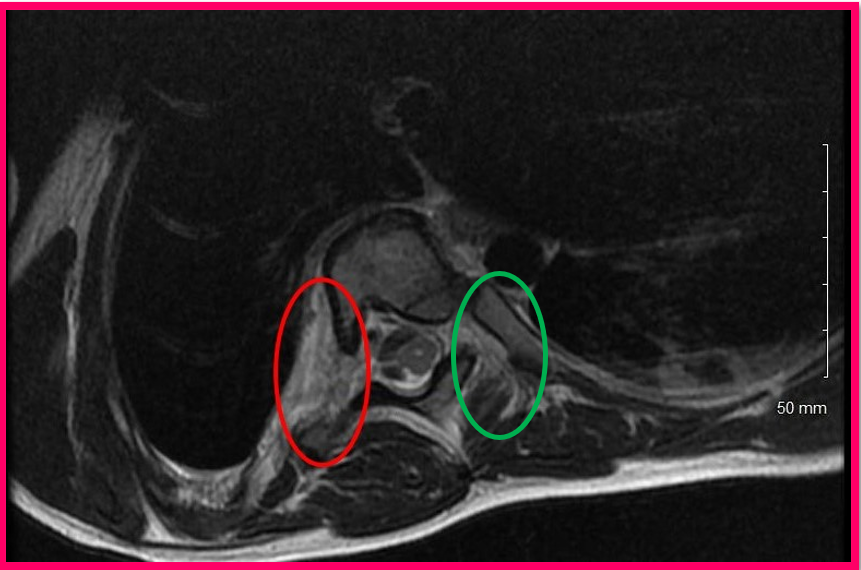Overview:
Neurofibromatosis (NF) is a genetic condition that primarily affects nerve cell tissue. It can also manifest in the skin and bones. It affects all races, ethnic groups, and both sexes equally. The main finding in NF is the development of benign tumors called neurofibromas that can be found throughout the body. Every patient with NF presents differently in their function and appearance and even though there is no cure for the condition, most symptoms can be managed.
Symptoms:
There are 2 main types of Neurofibromatosis, types 1 and 2. They differ in their presentation and in their genetics. Around 50 percent of cases are inherited, and the other 50 percent occur spontaneously. Symptoms vary for each type.
NF-1: Patients with NF-1 often have multiple skin birthmarks called café-au-lait spots. These can be found anywhere in the body but often present in the trunk; they vary in shape and size. Patients can also have axillary (armpit) freckling as well as groin freckling. Neurofibromas can present in the skin and present as or as deeper nodules.
Neurofibromas can develop anywhere along the course of a nerve including the brain and spinal cord. They can be large and affect multiple nerves, and this is called a plexiform neurofibroma. Patients can experience pain in the nerves that are affected, including at the spinal cord where they can exit from the spine (Figure 1). Neurofibromas that involve the optic nerve in the eye (optic glioma) can cause vision problems. Lisch nodules are small tumors that appear on the colored portion of the eye known as the iris. Although usually benign, neurofibromas can become cancerous over time.
 Figure 1a: (left) Coronal magnetic resonance imaging (MRI) of the spine showing neurofibroma exiting from the spine into the soft tissues (red circle), compared to the contralateral side with no neurofibromas (green circle).
Figure 1b: (right) Axial MRI showing a neurofibroma exiting form the spinal column along the nerve roots (red circle), compared to the opposite side with no neurofibromas (green circle).
Figure 1a: (left) Coronal magnetic resonance imaging (MRI) of the spine showing neurofibroma exiting from the spine into the soft tissues (red circle), compared to the contralateral side with no neurofibromas (green circle).
Figure 1b: (right) Axial MRI showing a neurofibroma exiting form the spinal column along the nerve roots (red circle), compared to the opposite side with no neurofibromas (green circle).
Patients with NF-1 can present with multiple orthopedic conditions. One of these is scoliosis, which is both a curving and twisting of the spine and may look like an “S” or a “C” when examined from the back (Figure 2). Scoliosis can range from mild to severe, sometimes requiring surgery to prevent progression. Scoliosis curves are labeled as dystrophic or non-dystrophic. Dystrophic curves affect a shorter portion of the spine and can be very severe, progress very rapidly, and be very difficult to treat. Non-dystrophic curves behave more like typical adolescent scoliosis.
Figure 2: (below) Standing x-ray of the spine showing significant thoracic scoliosis in a patient with neurofibromatosis.

Another orthopedic condition NF-1 patients can have is congenital pseudoarthrosis of the tibia (CPT) (Figure 3). This condition can range from a bowing of the tibia, or leg bone, to cyst formations in the tibia, to a pseudoarthrosis, or “false joint” healing of the leg bone. The leg bowing is termed “anterolateral” which means the bow points to the front and outer part of the leg. Treatment varies depending on what X-rays look like. If there is simple bowing or cyst formation without a break, then a special type of leg brace called a patellar tendon bearing brace will be used to prevent a fracture from occurring. If a fracture or pseudoarthrosis develops, then surgery is required to allow the bone to heal. Healing is very difficult as the bone itself is not healthy, and surgery can be extensive. Therefore, brace wear is very important to prevent a fracture from occurring. The brace is usually only needed until the bones are finished growing and fracture risk decreases.
Figure 3: (below) Front and side x-rays of a patient with NF-1 and CPT. There is obvious bowing of the leg with deformity in the middle of the leg as demonstrated by the red circle. The green circle shows that the fibula is also affected and has a pseudoarthrosis present.

Children with NF-1 can sometimes demonstrate learning disabilities or have a delay in walking or talking. NF-1 patients can also have low stature.
NF-2: NF-2 is less common than NF-1. The symptoms and signs of NF-2 differ from NF-1. Hearing loss can occur because of tumors that form along the hearing nerve called acoustic schwannomas. These are usually benign tumors but can lead to deafness if not addressed.
Evaluation and Examination:
Your doctor will discuss a thorough health and family history with you along with your symptoms. This is important as neurofibromatosis is often inherited. Your doctor will examine you from head to toe, including your skin to assess any birthmarks or skin tumors, your back for scoliosis, and your limbs for deformities.
Other Tests:
X-rays are usually obtained depending on what body parts are affected. Magnetic resonance imaging (MRI) of a body part may be required to evaluate for nerve tumors including the spine and head. Referrals to other medical specialties may be required including ophthalmology, genetics, neurosurgery, and orthopedics. If there is a tumor identified, a biopsy to obtain a tissue sample to assess for cancer may be performed.
Treatment:
There is no cure for neurofibromatosis. Every person is different in their presentation and treatment is based upon what each patient presents with. A team approach is often used to manage symptoms as they arise. Regular physical exams by a physician are needed to watch for symptoms as they occur and to perform an appropriate workup when needed. Routine eye exams may be needed to watch for eye tumors. As mentioned above, bracing for leg bowing or scoliosis may be needed if present. For established pseudoarthrosis or dystrophic scoliosis, surgery is usually required to allow healing, prevent pain, and correct deformity. Tumors may require excision if they are painful or rapidly growing, and especially if malignant. Radiation therapy and chemotherapy may also be required if a tumor is malignant. Adults should be followed yearly to address concerns as they arise.
Prognosis:
Although it is a lifelong condition, neurofibromatosis can be properly managed when care is obtained on a regular basis. Patients with neurofibromatosis usually require multiple physicians to work as a team throughout life to make sure problems are addressed early on and assure a patient has the best quality of life possible.
More Information:
Neurofibromatosis Network- nfnetwork.org
Orthoinfo- Neurofibromatosis- https://orthoinfo.org/en/diseases--conditions/neurofibromatosis/
Condition QR Code:


 POSNA.org
POSNA.org
 Figure 1a: (left) Coronal magnetic resonance imaging (MRI) of the spine showing neurofibroma exiting from the spine into the soft tissues (red circle), compared to the contralateral side with no neurofibromas (green circle).
Figure 1a: (left) Coronal magnetic resonance imaging (MRI) of the spine showing neurofibroma exiting from the spine into the soft tissues (red circle), compared to the contralateral side with no neurofibromas (green circle).


